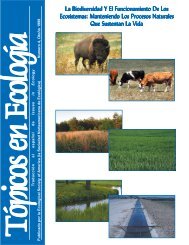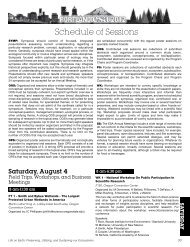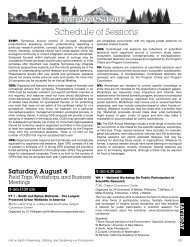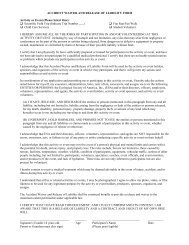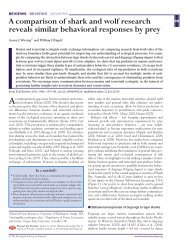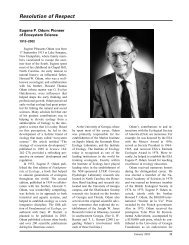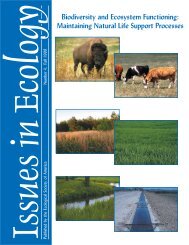here - Ecological Society of America
here - Ecological Society of America
here - Ecological Society of America
Create successful ePaper yourself
Turn your PDF publications into a flip-book with our unique Google optimized e-Paper software.
Richard Hobbs is Pr<strong>of</strong>essor <strong>of</strong> Restoration Ecology in the<br />
School <strong>of</strong> Plant Biology at the University <strong>of</strong> Western Australia<br />
(UWA), w<strong>here</strong> he holds an ARC Australian Laureate<br />
Fellowship and leads the Ecosystem Restoration and<br />
Intervention Ecology Research Group. Originally from<br />
Scotland, he spent 3 years in California and has been in<br />
Western Australia since 1984, working with CSIRO and at<br />
Murdoch University before joining UWA in 2009. His particular<br />
interests are in vegetation dynamics and management,<br />
invasive species, ecosystem restoration, conservation<br />
biology, and landscape ecology. He has several long-term<br />
ecological studies underway including a 29-year study <strong>of</strong><br />
California grassland dynamics.<br />
He is the author <strong>of</strong> over 300 scientific publications, many<br />
magazine articles and other publications, and author/editor <strong>of</strong><br />
18 books. He serves or has served in executive positions in a<br />
number <strong>of</strong> learned societies and on numerous editorial<br />
boards and is currently Editor in Chief <strong>of</strong> the journal<br />
Restoration Ecology. He was elected to the Australian<br />
Academy <strong>of</strong> Science in 2004, is an ISI Highly Cited<br />
Researcher, and was awarded the <strong>Ecological</strong> <strong>Society</strong> <strong>of</strong><br />
Australia Gold Medal in 2010. His current research focuses<br />
on “Intervention ecology: Managing ecosystems in the<br />
21st century.”<br />
Is history “just history”? Uses <strong>of</strong> the ecological past<br />
for global-change risk assessment<br />
Stephen T. Jackson, University <strong>of</strong> Wyoming<br />
Climate change, even rapid climate change, is nothing new<br />
to earth and its biota. In the past 40,000 years, the earth<br />
system has undergone several rapid warmings and coolings,<br />
a transition from a glacial to an interglacial state, and climate<br />
variability at timescales from decades to millennia. These<br />
particular changes will not be repeated in the future, but<br />
lessons and case studies from the past are highly relevant to<br />
the coming decades. Species, populations, and ecological<br />
communities have responded to past climate changes in a<br />
variety <strong>of</strong> ways: in situ toleration, local habitat shift, regional<br />
to subcontinental migration, adaptive evolution, altered<br />
interspecific interactions, and community disassembly and<br />
reassembly into new configurations. These responses are not<br />
mutually exclusive; for example, species can tolerate climate<br />
change in some parts <strong>of</strong> their range while colonizing new<br />
territories and relinquishing former habitats. Local and<br />
regional extirpations have occurred routinely as part <strong>of</strong> these<br />
dynamics, as have invasions and expansions. At least a few<br />
species have undergone extinction, and many extant species<br />
have gone through severe genetic bottlenecks recently,<br />
Abstracts and Speaker Biographies<br />
suggesting they came close to the brink <strong>of</strong> extinction. Most<br />
species living today have natural capacity for coping with<br />
climate change, given their persistence through the global<br />
changes <strong>of</strong> the recent past. These capacities are poorly<br />
understood, but can potentially be leveraged by conservation<br />
managers for more effective and efficient conservation efforts<br />
in a rapidly changing world. Although prediction is likely to be<br />
elusive in any detailed sense, we can minimize losses and<br />
use limited conservation resources efficiently by identifying<br />
adaptive capacities and vulnerabilities.<br />
Stephen Jackson studies effects <strong>of</strong> environmental<br />
change on forests, woodlands, and wetlands. A native <strong>of</strong><br />
southern Illinois, he received a Ph.D. in Ecology and<br />
Evolutionary Biology from Indiana University in 1983. He was<br />
a National Science Foundation Post-Doctoral Fellow in<br />
Environmental Biology in residence at Brown University, and<br />
is currently Pr<strong>of</strong>essor <strong>of</strong> Botany at the University <strong>of</strong> Wyoming,<br />
w<strong>here</strong> he served as founding Director (2004-2011) <strong>of</strong> the<br />
Program in Ecology. He has served on numerous advisory<br />
panels and editorial boards, most recently Ecosystems,<br />
Frontiers in Ecology and the Environment, and Trends in<br />
Ecology and Evolution. Jackson is a 2006 Fellow <strong>of</strong> the Aldo<br />
Leopold Leadership Program, a 2009 Fellow <strong>of</strong> the <strong>America</strong>n<br />
Association for the Advancement <strong>of</strong> Science, and a 2012<br />
Visiting Fellow at Merton College, University <strong>of</strong> Oxford. His<br />
research employs tree-rings, fossil rodent middens, and<br />
sediments from lakes and bogs to investigate how past<br />
climatic changes and human activities have affected species<br />
distributions, biodiversity, and ecosystem properties. His<br />
study sites range from wilderness areas in the Rocky<br />
Mountain and upper Great Lakes regions to agricultural<br />
landscapes in the Southeast and urban/industrial settings in<br />
the Midwest. He is committed to effective engagement with<br />
stakeholders in environmental and conservation policy and<br />
management.<br />
Landscape corridors for a changing world<br />
Nick M. Haddad, North Carolina State University<br />
I will discuss how and when landscape corridors can provide<br />
a general strategy to promote plant and animal dispersal in the<br />
face <strong>of</strong> the two largest threats to biodiversity, habitat<br />
fragmentation, and climate change. I will discuss two case<br />
studies. First, drawing on nearly 20 years <strong>of</strong> data from the<br />
Savannah River Site Corridor Experiment, I will show how<br />
corridors increase dispersal generally across a diversity <strong>of</strong> plant<br />
and animal species. These higher rates <strong>of</strong> dispersal have<br />
consequences for populations, species interactions, and<br />
community diversity. Evidence from our and other studies<br />
The Second Emerging Issues Conference <strong>of</strong> the <strong>Ecological</strong> <strong>Society</strong> <strong>of</strong> <strong>America</strong> 15



